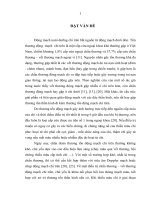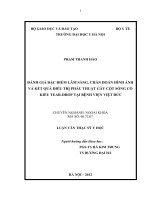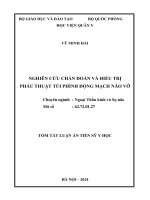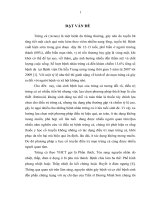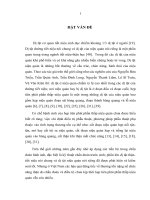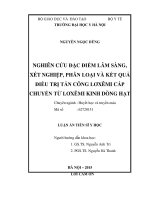Đặc điểm lâm sàng, chẩn đoán hình ảnh và kết quả điều trị phẫu thuật túi phình động mạch cảnh trong đoạn trong sọ vỡ tt tiếng anh
Bạn đang xem bản rút gọn của tài liệu. Xem và tải ngay bản đầy đủ của tài liệu tại đây (350.53 KB, 27 trang )
1
MINISTRY OF EDUCATION AND TRAINING MINISTRY OF HEALTH
HANOI MEDICAL UNIVERSITY
DANG VIET SON
CLINICAL CHARACTERISTICS, IMAGING AND
RESULTS OF SURGICAL TREATMENT OF
UNRUPTURED INTERNAL CAROTID ARTERY
ANEURYSM
Field of study : Neurosurgery
Code
: 62720127
ABSTRACT OF MEDICAL DOCTORAL THESIS
HANOI – 2019
2
The thesis has been completed at:
HANOI MEDICAL UNIVERSITY
Supervisor:
1. Nguyen The Hao. Assoc Prof. PhD
2. Vo Hong Khoi. PhD
Opponent 1: Pham Hoa Binh
Assoc Prof. PhD
Opponent 2: Vu Van Hoe
Assoc Prof. PhD
Opponent 3: Le Hong Nhan
PhD
The thesis will be present in front of board of university
examiner and reviewer lever hold at Hanoi Medical University.
Ha Noi, At......,On......., 2018.
The thesis can be found at:
National Library of Vietnam
Library of Hanoi Medical University
3
INTRODUCTION TO THESIS
Aneurysm on the intracranial segment of internal carotid artery
(ICA) is identified from the place that internal carotid artery exits the
cavernous sinus to the point of division into the two branches of
anterior cerebral artery and the middle cerebral artery.
In this position, the aneurysm is closely related with the
important components in the skull base and obscured by the anterior
clinoid process, which makes it difficult to perform surgical treatment
as well as for cardiovascular interventions as the ICA is short and
winding.
Symptoms of unruptured aneurysm of ICA are not specific; the
patient was accidentally detected by brain imaging on Computer
tomography (CT) scanner or Magnetic resonance imaging (MRI).
When the aneurysm is ruptured, there are a sudden, violent headache
and signs of membranes irritability. Severe symptoms include
disorders of consciousness, coma and other severe systemic
complications.
Treatment of the ruptured ICA aneurysm is still a challenge for
clinicians, in which surgical removal of the aneurysm from the
cerebral circulation is crucial to address the cause, avoid
complications of rebleeding, and deal with the complications of
ruptured aneurysm, such as cerebral vasospasm, hydrocephalus and
hematoma. In our country, there has been no intensive study on
microsurgery for ruptured ICA aneurysm.
Purpose of the study
- Description of clinical characteristics and imaging of
ruptured internal carotid artery aneurysm.
- Evaluate the results of surgical treatment of ruptured
internal carotid artery aneurysm.
4
THE CONTRIBUTION OF THE THESIS
- This is a new systematic study on the diagnosis and treatment
of ruptured ICA aneurysm in Vietnam.
- Assertion: The recovery of patients with ruptured ICA
aneurysm was not affected by the time of surgery.
- Contribute to clarify the role of Computed Tomographic
Angiography (CTA) 64-slice have more benefit than Digital
Subtraction Angiography (DSA) in the diagnosis of aneurysm
location as well as the value of this method in the postoperative
examination.
- Initially applied minimally invasive surgical approach
(Keyhole) in the treatment of ruptured ICA aneurysm in comparison
with the result of classic frontotemporosphenoidal (Yasargril).
THESIS LAYOUT
The dissertation consists of 134 pages, of which there are 45
tables, 22 figures and 8 charts. Problem Set (2 pages); Chapter 1:
Documentation Overview (42 pages); Chapter 2: Objectives and
Methods (15 pages); Chapter 3: Research Results (38 pages); Chapter
4: Discussion (36 pages); Conclusion (2 pages); List of research
results published dissertations (1 page); References (159 documents
including Vietnamese documents, English documents); Appendices
CHAPTER I. OVERVIEW
1.1. Situation of research on internal carotid artery aneurysm
rupture
* Worldwide
In 1775, the arterial aneurysm and arteriovenous aneurysm were
described by Hunter for the first time. In 1875, Huntchinson
described the symptoms of the ICA aneurysm arising in the
cavernous sinus segment consisting of severe headache, paralyzed
5
cranial nerves III, IV, VI and V1. In 1927, Egas Moniz invented
cerebral angiography, the diagnosis and surgical treatment of cerebral
aneurysms was then considered to be important and continuously
developed more and more complete.
In 1885, Victor Horseley performed a carotid artery ligation on
the same side for the treatment of a giant aneurysm in skull base that
had been diagnosed during surgery. In 1931, Norman Dott was the
first person who directly approach cerebral artery aneurysm; he
performed a muscle package to strengthen the wall of the aneurysm
at the ICA-bifuration. On March 23, 1937, Walter Dandy used the
silver V-clip to clamp the aneurysm's neck to preserve the arteries
carrying the aneurysm at the posterior communicating artery. Then,
Dandy and Janetta reported on internal and external carotid artery
ligation procedure to treat arterial aneurysm near the carvenous sinus.
At the same time, he also performced extra-intra cranial bypass by
microscopy in 1967.
A new step in the surgical treatment of the ICA aneurysm was
when Nutik presented the first anterior clinoidectomy (1988) and
dural skull base ring opening technique (Zin ring) of Kobeyashi's
(1989). It has been shown to be effective in completely removing the
intracranial segment ICA aneurysm from the circulation, reducing the
mortality and complications of ruptured ICA aneurysm.
* In Vietnam
Currently, there have been a few intensive studies about the
rupture ICA aneurysm. One of the authors studied about it is Nguyen
The Hao, who reported on the surgical treatment of four cases of
ophthalmic artery aneurysm rupture. Nguyen Minh Anh with a study
of aneurysm of the clinoid segment revealed that the postoperative
outcome was very good at 84.1%, in which the death rate caused by
surgery is 6.8% mainly occurred in groups with a wide neck or giant
aneurysms.
6
1.2. Anatomy of intracranial internal
application in microsurgery
carotid artery and
In clinical, intracranial segment of ICA starts from the anterior
clinoid process to the internal carotid artery bifuration; this segment
of the artery is 1.6 to 1.9 centimeters long and 0.5 to 0.6 centimeters
in size with a blood flow of about 300ml/p. It runs posteriorly and
exteriorly at an angle of 108-110 degrees, splits into the lateral
branches and ends after dividing into the two arteries: middle
cerebral artery and anterior cerebral artery. At this location, the ICA
aneurysm is related with nerve II, III, optic canal and pituitary
glands. Lateral branches include: ophthalmic artery (Ophth.A),
Superior Hypophyseal artery (SupHyp.A), posterior communicating
artery (PCom.A), Anterior chonoidal artery (ACh.A) and internal
carotid artery bifuration (ICA – bifuration).
1.3. General characteristics of the internal carotid artery
aneurysm.
The incidence of ICA aneurysm is about 30-40% of total
intracranial aneurysms and the incidence of these aneurysms ruptured
are generally low about 0.25% to 1.98% per year. The average age is
45-55 years, female more than male. Most aneurysms are bag shaped
including neck, body and bottom of the bag. The aneurysm is
attached to the ICA by the neck - this is where the surgical
instruments (clip) are located to completely remove aneurysm from
the brain circulation.
1.4. The risk factors
Smoking and alcohol habits use are factors that cause weakness
of blood vesselles, thereby increasing the risk of rupture of the
aneurysm.
Hypertension: There have been many studies which have found
that hypertension was not the cause of aneurysm rupture and it is
independent factor, but this was the factor that affects the recovery of
patients after surgery.
7
Diabetes mellitus and hypercholesterolemia reduce the risk of
rupture of the aneurysm.
1.5. Diagnosis
Clinical symptoms: Typically, sudden and severe headache
which is not relieved by conventional painkillers. They are followed
rapidly by nausea and vomiting, signs of membranes irritability are
common in 57-61% of cases. Early loss of consciousness can occur
immediately after signs of headache. There may be sudden onset
epilepsy at the time aneurysm rupture (12-13%) or focal neurologic
deficit depending on the location of the ruptured aneurysm.
Brain CT Scanner is a diagnostic tool that identifies aneurysm
rupture with a sign of subarachnoid hemorrhage. The degree of
bleeding is classified according to Fisher's classification to predict
the potential for vasospasm or cerebral infarction after the rupture of
the aneurysm. CT Scan also identifies complications of aneurysm
rupture such as: intracerebral hematoma, intraventricular hemorrhage
and hydrocephalus.
CTA 64-slice has a reported sensitivity of 67% to 100% with an
accuracy of nearly 99% depending on the diagnostic center. The CTA
64-slice demonstrates the superiority that can be used easily in an
emergency, or needs to be repeated, on the other hand the CTA also
detects calcification, thrombosis within the aneurysm that helps to
orient well in surgery. This method has many benefit when taking a
postoperative examination with high accuracy and less complication
because it is less invasion.
DSA is the gold standard for the diagnosis of ICA aneurysm
rupture. However, this is an invasive diagnostic method that is more
likely to have transient or permanent neurological complications.
Today, this method is gradually being replaced by other methods such
as CT Scaner and new nuclear MRI with very high sensitivity and
specificity for the diagnosis of ruptured ICA aneurysm.
8
1.6. Treatment
1.6.1. Medical treatment
Analgesia, respiratory control, treatment of complications of
aneurysm ruptured such as water-electrolyte disturbances, epilepsy,
cerebral edema and especially prophylaxis of cerebral vasopasm with
Nimotop, Triple-H therapy.
1.6.2. Endovascular treatment
By interfering with the material into the aneurysm, it blocks the
flow in the aneurysm, restricts or diverts the blood flow into the
aneurysm. This method has many advantages but also has limitations
such as: anatomy of ICA twisting and bending caused difficulties in
inserting instruments into the aneurysm, the interventional materials
move when performing the procedure. In particular, the risk of
recirculation for ICA aneurysms is up to 15%, the risk of residual
aneurysm is 2.9% and the risk of rebleeding is 1.5%.
1.6.3. Surgical treatment
Ruptured ICA aneurysm surgery is performed under a surgical
microscope. The ideal purpose of surgery is to place a clip over the
neck of the aneurysm to completely remove the aneurysm from the
brain circulation system, ensuring the integrity of the artery without
clogging the blood vessels and respect the cerebral vascular system.
Approach: mainly use the Yasargril which can extend to the
entire base of the skull to help expose the bottom of the brain. It is
used in cases of cerebral edema, which can remove the cranial bone
flap if there is a risk of cerebral edema after surgery, and is especially
convenient for cases where a complete exposure of anterior clinoid
process is required such as aneurysm of OphthA or SupHypA . Other
approach is Keyhole which is less invasive and has many aesthetic
advantages as well as reduces postoperative pain and shortens
hospital stay.
9
CHAPTER II. OBJECTIVES AND
RESEARCH METHODOLOGY
2.1. Research subjects
- Descriptive prospective study
-Timing: from 06/2014 to 10/2017 at the Neurosurgery
Department of Bach Mai Hospital Hanoi.
2.1.1. Inclusion criteria
Patients diagnosed with ruptured ICA aneurysm
Patients were treated by microsurgery at the Neurosurgery
Department of Bach Mai Hospital.
Having full records at Bach Mai Hospital's Storage
Room.
Patients or family members agree to join the research
team.
2.1.2. Exclusion criteria
Aneurysm does not arise in the segment of ICA, the aneurysm
of the posterior circulatory system.
Patients diagnosed with unruptured aneurysm
Patients were treated with intravascular intervention but failed.
Patient or family does not agree to join the research team.
2.2. Research Methods
2.2.1. Research design
Description prospective, cross-sectional.
Assessing the results of microsurgery in the treatment of
rupture ICA aneurysm, in comparison with the world literature.
Number of patients studied: 72 patients
2.2. Sample size
P x(1- p)
n n = Z2 (1- α/2) x
E2
n: the number of patients needed to be included in the study
group.
10
Z: coefficient confidence at 95%
P: proportion of patients alive through treatment. Authors
worldwide show that the proportion of patients surviving due to
clipping the aneurysm's neck of the cerebral aneurysm is 88-96%. We
based on the survival rate of 96% (p = 96%) of De Jesus for the ICA
aneurysm.
E: error in survival estimates (5%).
So the estimated number of patient for research was 55. We
conducted the study with 72 patients (n = 72) from 06/2014 to 10/2017.
2.3. Research content
Objective 1
2.3.1. Characteristics of research subjects
- Age, gender, personal history
- The time from the onset of symptoms to the hospital admission
- The way onset of the disease
2.3.2. Study clinical characteristics
- Clinical symptoms when hospitalized
- Clinical/preoperative assessment based on WFNS (World
Federation of Neurosurgical Societies) scale
- Assessment of postoperative clinical grade by Rankin
modifield scale (mRankin) was divided into 3 groups:
Good clinical outcome group: mRankin 1-2
Average clinical outcome group: mRankin 3
Poor clinical outcome group: mRankin 4-5
2.3.3. Imaging studies of ruptured ICA aneurysm
- CT Scaner: Counting the time of shooting and complications of
aneurysm rupture, assessing the level of subarachnoid hemorrhage
according to Fisher, the relation between the subarachnoid
hemorrhage with location ruptured ICA aneurysm.
- CTA 64-slice: determining the number, location, size and shape
of the aneurysm ruptured, thereby determining the accuracy of the 64
CTA compared to each position of rupture. Identify other cerebral
arteriovenous malformations.
11
Object 2.
2.3.4. Evaluate the results of surgical treatment
+ Research on surgical indications
+ The timing of surgery and its relationship to postoperative
outcomes
+ Investigation of the surgical approach: the
Frontotemporosphenoidal (Yasargril) and the Keyhole approach.
+ Evaluation in surgery: assessment of the location of the
aneurysm in the branches of the ICA. List of difficult factors in the
surgery: cerebral edema, abnormal positions, aneurysmal status:
sclerosis of the neck aneurysm, aneurysmal artery perforation;
Evaluation risk rebleeding of aneurysm in operative, aneurysm and
associated lesions.
+ Evaluating the treatment level of the aneurysm’s neck during
surgery: Totally clamping the neck, residual of the neck, residual of
the aneurysm in the operation as well as the result of the CTA 64slice.
+ Complications after surgery
+ Clinical results after outcome for 1 month, 3 months, 6 months
and 12 months: improvement of clinical symptoms on the mRankin
scale, assessment of vision restoration, new lesions after surgery.
+ Assessing factors that affect the results of surgery
+ Mortality and disability of surgical treatment of ruptured ICA
aneurysms.
2.4. Data analyze.
Descriptive statistics, including: qualitative variables (frequency,
percentage); Quantitative variables (calculating maximum, minimum,
average, and standard deviation).
Statistical analysis: using the χ2 test to compare scales, use
Fisher's exact, χ2 McNemar to examine the relevant factors. Use the
Kaplan-Meier method to estimate extra living time and compare
differences by log-ranks test. Threshold of statistical significance was
chosen as p <0.05.
12
CHAPTER III. RESEARCH RESULTS
3.1. Clinical and imaging characteristics of ICA aneurysm
rupture.
3.1.1. The clinical characteristics of the study group
+ Age and sex: The mean age was 55.25 ± 1.4 years (from 20-82
years), the common age was 40-60 years (69.2%). Sex: male/female
ratio: 1/1.7 (male: 36.1%; female: 63.9%)
+ History and coincident diseases: Hypertension (50%),
headache (12.5%), diabetes (4.2%), smoking (18%), alcohol (18%)
+ Onset: Sudden (76.4%), acute (4.2%), progressive (19.4%)
3.1.2. Clinical symptoms
+ At onset: Common symptoms were headache 97.2%, vomiting
56.9%, temporary loss of consciousness 25%, epilepsy 8.3% (Table 3.4)
+ At the hospital: prominent symptom was headache 94.4%, signs
of membranes irritability 88.9%, loss of vision acuity and vision field
19.4%, focal neurologic deficit such as paraplegia 13.9%, paralysis of
nerve II 5.6%, nerve III 16.7%, aphasia 13.9% (Table 3.6)
+ Clinical condition of admission
The majority of patients were in good clinical condition at
admission with WFNS 1-2 accounted for 73.6% (53/72), with WFNS
3 accounted for 19,5% (14/72) and 5/72 patients with severe clinical
condition with WFNS 4 accounted for 6.9%. When comparing the
clinical course at onset and before surgery in pairs, we noted that
there was a significant improvement with insignificantly clinical
13
increase with χ2 = 60,639 and p> 0.05. Thus eliminating the cause of
the disease is necessary for the ruptured ICA aneurysm.
3.1.3. The imaging features of the rupture internal carotid artery
aneurysm
3.1.3.1. Computed Tomography
+ The level of subarachnoid hemorrhage
+ Subarachnoid hemorrhage detection rate in different times
Signs of subarachnoid hemorrhage were highest in the first day
at 69.4% and decreased in the following days to 1.4% after 2 weeks.
14
+ The degree of subarachnoid hemorrhage compared to the ICA
aneurysm rupture position
+ The level of subarachnoid hemorrhage was evenly distributed
among the groups ICA aneurysm rupture, the difference in
subarachnoid hemorrhage level with the aneurysm’s position was not
statistically significant with χ2 = 19.568 and p> 0.05. We also did not
find a correlation between subarachnoid hemorrhage level and
clinical WFNS level at admission with χ2 = 8.294.
There was no relationship between subarachnoid hemorrhage
levels with cerebral vasospasm with p> 0.05.
3.1.3.2. CTA 64-slice.
+ Location of ICA aneurysm rupture
Aneurysm ruptured was recorded in 45/72 patients at the right
(62.5%) and in 27/72 patients at the left (37.5%). We also found no
15
relationship between the side and the location where the aneurysm
arises in the ICA with χ2 = 3.798 and p> 0.05
+ CTA 64-slice image
+ There were 48/72 patients having solitary aneurysm (66.6%),
23/72 patients having multiple aneurysms (33.4%). In terms of size
of aneurysm: the majority were in average size of 6-10mm,
accounting for 53.5% (38/72 patients), small size occupied 45.1%
(32/72 patients) and large size (> 10 mm) was 1.4%, no case of giant
aneurysm rupture > 25 mm.
+ Diameter of the necks of the aneurysms was mainly <4mm in
59/72 BN (81.9%) and neck diameter> 4mm in 13/72 patients
(18.1%). Most aneurysm had arch / neck (NRS)> 2, accounting for
70.8% and Aspect score ≤ 1.6 accounting for 58.3%.
+ Shape: irregular edges 42/72 patients (58.3%) and the hourglass
shape (citrus, lobe) accounted for 23.6% (13/72) patients.
16
+ The ability to detect the position rupture ICA aneurysm on the
CTA 64-slice
+ When comparing between the aneurysm location identified on
scans compared with each position identified in the surgery we found
no difference with χ2 = 198.04 and p <0.001.
There was no difference in clinical level as well as focal
neurologic deficits among the positions of rupture ICA aneurysm
with p> 0.05.
3.2 Results of surgical treatment
3.2.1. Characteristics in aneurysm surgery
17
We used two approach of surgery including the Yasargil 57/72
patients and less invasive approach Keyhole 15/72 patients.
There were 11 out of 72 patients (15.3%) had rupture of
aneurysm during surgery. With Yasagril approach, there were 6/57
patients having rupture during surgery accounted for 10.5% and 5/15
patients (33.3%) had this complication when applying Keyhole
approach.
Postoperative brain injury: 2/15 patients (13.3%) had mild
subdural bleeding when using Keyhole approach and the incidence of
contusion in this approach was 3/15 patients (20.0%). Postoperative
cerebral ischemia in Keyhole approach happened in 1/15 patients
(6.7%), while the Yasargil approach were 6/57 patients (10.7%).
In good clinical outcome at hospital discharge group: 41/57
patients (71.9%) were operated with Yasargil approach and 11/15
patients (73.4%) with Keyhole approach.
In the group with poor clinical results after surgery, there were
8/57 patients (14.1%) undergoing the surgery with Yasargil approach
and none of them with Keyhole approach.
The postoperative clinical recovery was not associated with the
use of surgical approach with = 3,634 and p = 0,443.
We performed CTA 64 slice for 70/72 patients (reaching 97.2%)
after surgery. There were 2 patients who were too heavy to take a
CTA. The results were as follows: in the group using Yasargil
approach, 52/55 patients (94.5%) had complete obliteration of
aneurysm neck. This incidence in the group using Keyhole approach
was 14/15 patients (93.3%). We had 3 out of 72 patients with remnant
aneurysm neck, accounted for 4.3% and all of them were in the group
using . 1/72 patients had vascular obstruction of artery carrying
aneurysm accounted for 1.4%. Results of handling the aneurysm
rupture between two approach were not different with = 5.972 and
p = 0.54.
18
The mean operative time for the Yasargil approach was 120 ±
34,93 minutes (ranging from 75-195 minutes) and for the Keyhole
approach was 100 ± 24,55 minutes (50- 150 minutes).
3.2.2. Complications after surgery
3.2.3. Clinical results after surgery
19
+ mRankin evaluation results at discharge: good results 72.2%
and bad results 11.1%.
+ The visual acuity after surgery improved significantly. Only 8
out of 72 patients (11.1%) had no signs of visual recovery compared
with before surgery, 14/72 patients with vision loss. 2/72 patients
(4.2%) have had signs of vision field recovery at discharge yet.
Postoperative lesion of nerve II and III decreased significantly to
4.2% compared with 5.6% and 16.7% at admission (Table 3.7).
+ Postoperative CTA 64-slice: The mean postoperative shooting
time was 4 ± 1.2 days. We performed CTA 64-slice for 70/72 patients
(97.2%). There were 2 severe patients after surgery that could not
take CTA. The results were: complete obliteration 94.1%, residual
neck of aneurysm 4.4%, obstruction of carried artery 1.5%.
+ After surgery 1 month: 4 patients died; after 3 months: 1
patients died and after 6 months: 1 patient died. The number of
patients in the good and average clinical outcome groups increased
from 95.5% to 98.5% after 6 months and 12 months of treatment. Of
the 2 patients at the time of examination after 1 month, 1 patient died
of pneumonia and asthenic. One patient had vision acuity recovered
after surgery 6 months but the vision field recovery was very slow,
almost no recovery. In the CTA-64slice, we noticed the sign of residual
neck of aneurysm during the first month with 3/68 patients (4.4%) and
these patients were monitored continuously in the first year. We noticed
that after 6 months, only in one patient (1.9%) was able to see the
residual of aneurysm neck on the film and stabilized in the first year
without complications of rupture or enlargement over time.
20
3.2.4. Death and disability after ICA aneurysm rupture surgery
CHAPTER IV. DISCUSSION
4.1. General characteristics of the study group
4.1.1. Age, sex.
Mean age was 55.25 ± 1.4 years, the age 40-60 years accounted
for 69.2%. Sex: male/female ratio: 1/1.7 (Figure 3.1, Figure 3.2). Our
research is equivalent to the results of other studies suggesting that
there is no difference in incidence between males and females.
4.1.2. Risk factors and chronic diseases
Hypertension (50%), diabetes and dyslipidemia (4.2%), alcohol
and smoking habits accounted for 18.1%. Chronic headaches and
migraines accounted for 12.5% (Table 3.1). Our study is similar to
that of Christopher LT, Feigin, and Gijn Val, which had high
prevalence of hypertension but did not confirm that hypertension was
associated with the risk of aneurysm rupture or only was
accompanying disease. Our drinking and smoking rates were lower
than those of other authors in the world, probably due to the fact that
the percentage of women in the study was 69%, and the drinking and
smoking habits in Vietnam is less common in women.
4.2. Clinical characteristics of the patients
4.2.1. Onset of the disease
The way of onset included: sudden onset (76.4%), typical
headache symptoms (97.2%), epilepsy (8.3%), loss of consciousness
(25.5%) (Table 3.3). This result is consistent with other authors'
21
comments such as Gijn val (2001), Iihara (2003), Mayer (2005),
Thinh Le Van (2009).
4.2.2. Duration of illness
The time from onset to admission was 4.6 ± 4.1 days (5 hours 21 days). Patients had surgery before 7 days accounted for 45.8% and
after 7 days was 54.2%. The time from the diagnosis until the surgery
was quite fast 2.31 days. According to Ross, the timing of the surgery
did not affect the outcome of the treatment. Early surgery could
shorten the patient's hospital stay.
Based on the pathophysiology of subarachnoid hemorrhage
resulting from rupture of the cerebral aneurysm which causes
cerebral vasospasm immediately and peakes at 7-10 days, the need
for preoperative medical treatment of vasopasm can also help
improve postoperative outcomes.
4.2.3. Clinical symptoms
Most common were headache 94.4%; vomiting or nausea
48.6%, and meningeal syndrome 88.9%. Decreased consciousness
was 9.7%. Focal neurological deficit: hemiplegia 13.9%, lesion of
nerve II 5.6%, paralysis of nerve III 16.7%. They were directly
related to hematoma location as well as vasospasm, so we found that
predominantly hemiplegia occurred at the posterior communicating
artery with the rate of 60.0%. Nerve III damage was highest when the
aneurysm of PCom.A with the rate of 91.7%. This may be explained
by the location of the aneurysm that was directly related to the
pathway of the nerve.
Clinical preoperative scale: ICA rupture degree 1-3 accounted
for 93.0% based on WFNS (Table 3.8 and 3.10), in which the
prevalence of WFNS 2 accounted for 47.2%. The level of WFNS 4
was only 6.9%. Our research was similar to other authors such as
Huong Vu Quynh, Hai Vu Minh, Worrall. We also did not find a link
between the clinical status and the location of the rupture ICA
aneurysm.
22
4.3. The imaging features of the rupture ICA aneurysm
4.3.1. Computer Tomography
An accurate diagnosis of 87.5% with subarachnoid hemorrhagic
signs which was shown by increased density at sites such as aqueduct
of Sylvius (70.8%), basal cisterns (54.2%) and interhemispheric
fissure bleeding (13.9%). The degree of subarachnoid hemorrhage
caused by the ruptured ICA aneurysm was mostly at Fisher level 2
(41.7%). Our results are similar to some other authors such as Hong
Minh Dang, Foroohar M. The degree of subarachnoid hemorrhage
evenly distributed among locations of ruptured ICA aneurysm (Table
3.17). There is no correlation between the degrees of subarachnoid
hemorrhage and vasospasm after aneurysm ruptured with p> 0.05
(Table 3.12)
4.3.2. Computed Tomographic Angiography 64-slice image
+ Location of ruptured ICA aneurysm: We studied 72 cases and
found that the rate was: rupture of the aneurysm at the PCom.A
59.7%; the Ophth.A 12.5%; the ICA-bifurcation 9.7%; the Sup
Hyp.A 8.3% ; the Ach.A 5.6% and the Dorsal ICA 4.2%.
The accuracy of CTA 64-slice in diagnosis of subarachnoid
myocardial bleeding was 67.8% with p <0.05, OR 95% CI 0.08-0.87
(Table 3.18), higher than Weisberg authors 66% and Chang L 22.2% .
Our accuracy was higher than other authors because we only focused
on the ruptured ICA aneurysm group. Comparison of CTA 64-slice
results with surgical results showed that a CTA 64-slice could replace
DSA imaging in diagnosis of ruptured ICA aneurysm.
+ The size, number and shape of the aneurysm: the most
common was to have solitary aneurysm (66.7%) with the following
characteristics: 53.5% of medium size, 45% of small size and the
neck of aneurysm size <4mm (81.9%). When aneurysms ruptured
often have irregular edge (58.3%) or hourglass-shaped, lobed
(23.6%).
23
4.4. Results of surgical treatment for rupture ICA aneurysm
4.4.1. The timing of surgery
Time from onset to surgical intervention: 8.53 ± 4.5 days, the
timing of surgery is still a matter of debate among many authors,
according to Miyaoka, who found that the early surgical group had a
higher recovery rate and reduced the risk of rebleeding from
aneurysms ruptured. Hunt and Hess, however, suggest that early
surgery may also increase the risk of severe brain edema, difficulty in
approach the skull base and approach the aneurysm and the
possibility of aneurysm ruptured in the surgery. We found that in this
study, the clinical outcome after surgery was not dependent on the
time of surgery before 7 days and after 7 days with p> 0.05.
4.4.2. Surgical approach.
Through the study of the surgical approach, we concluded that
the use of less invasive (Keyhole) approach has more advantages
than the classic Yasargil approach: short duration of surgery but
similar manipulation as well as the results of clinical recovery. The
surgical approach was not identified by the time of surgery but
depended on the preoperative clinical condition, as well as cerebral
edema, and predictive vasoconstriction in preoperative angiography.
Results in surgery: recurrence of the aneurysm rupture in operation
accounted for 15.3%, clamped the neck of aneurysm for 71/72
patients reached 98.6%, handling of the neck reached 94.4%, residual
of the aneurysm’s neck was 4.2%, the obstruction of carried artery
was 1.4%.
4.4.3. Complications after surgery
Cerebral edema was 4.2%, secondary cerebral lesions due to
twisting of the brain were 12.7%, and focal ischemia in lobes was
9.9%. acute subdural hematoma was 15.5% and responded to medical
treatment. No case had to undergo surgery again. Cerebrospinal fluid
leak was 1.4% and often seen in Yasargril approach.
Signs of motor paralysis: new paralysis after surgery accounted
for 7/72 patients (9.7%) and recovered after 1 month, the cause may
24
be due to temporary cerebral vasospasm while actively clamped the
extracranial segment ICA.
There were 3 cases lesion of nerve II (4.2%) with one case of
rapid recovery after 5 days. According to Hoh B.L, nerve III paralysis
was 3%, Jesus 4% and Thorton 3.3%. The cause may be due to
vasopasm of ophthalmic artery or inadvertently hurting nerve II in
the process of enlarging the optic canal.
4.4.3. Post-operative treatment results of ruptured ICA aneurysm
Good clinical outcome at discharge (Rankin 1-2) was 72.2% and
this result increased to 98.5% at 12 months. Results of vision
restoration: 85.7% of patients recovered post-operative vision
compared to the time of admission. In our study, we found that not all
aneurysm in the ICA had a change in vision, but only enlarged
aneurysm that developed directly toward the ophthalmic nerve II or
hemorrhage directly into the nerve did. So after the surgery, vision
acuity and vision field recovery was very good.
The results of CTA scan showed that the complete obliteration of
aneurysm was 94.3%, the remnant of the neck was 4.3% with the
“rabbit ear” sign. There was1.4% of obstruction of artery that carried
aneurysm which was manifested by total loss of the middle cerebral
artery after clamping of the aneurysm at ICA-bifurcation. There was
no case of left over a part of aneurysm.
4.4.5. Factors affecting the results of clinical recovery
- Age: Delayed clinical recovery in patients > 60, statistically
significant at p <0.05 (OR: 0.27, 95% CI: 0.08-0.8).
- Clinical condition of admission was a useful prognostic factor
in treatment. The risk was 5.8 times higher in patients with grade IV
WFNS with p <0.05 (OR: 4.43, 95% CI: 1.17-16.71). Hunt W.E
found that patients who were hospitalized at the WFNS IV had a 45%
mortality rate.
- Hypertension: was a risk factor for treatment prognosis. People
with hypertension have a slower clinical improvement than those
without hypertension with p<0.05. Foroohar demonstrated that
25
lowering blood pressure and maintaining a stable systemic blood
pressure resulted in better postoperative outcomes.
4.4.6. Mortality and disability after surgery
The overall mortality rate due to rupture ICA aneurysm was
6.9%. Of those deaths directly related to surgery was 5.5% and
disease-related mortality was 1.6%. The mortality rate was not
related to the waiting time for operation as well as the manner of
surgery with p>0.05. The incidence of postoperative disability
accounted for 1.5%, including those who did not recover from motor
paralysis after 12 months.
CONCLUSION
Through a study of 72 cases of rupture ICA aneurysm, we offer
the following conclusions:
1. Clinical features, diagnostic imaging of rupture ICA
aneurysm.
1.1. Clinical characteristics
Rupture ICA aneurysm were common in the 40-60 age group,
females were predominate. Sudden onset (76.4%) with severe
headache symptoms (94.4%). Meningococcal syndrome was
common when the aneurysm ruptured (88.9%). Focal neurologic
deficits were mainly paralysis of nerve III (16.7%) and hemiplegia
(13.9%). The clinical condition at admission was predominantly at
WFNS I and II.
1.2. Imaging characteristics
The location of the aneurysm: Root of PCom.A 59.7% ,
Ophth.A 12.5%, ICA-bifurcation 9.7%, Sup Hyp.A 8.3%, Dorsal ICA
4.2% and Ach.A 5.6%.
The CTA 64-slice can completely replace the DSA in the
diagnosis position of ICA aneurysm.
Most aneurysm was solitary (66.7%) and has an irregular edge,
citrus or hourglass - shaped. Most of the ruptured aneurysms were in
small size ≤ 10 mm (98.6%), neck of aneurysms < 4 mm (81.9%)

